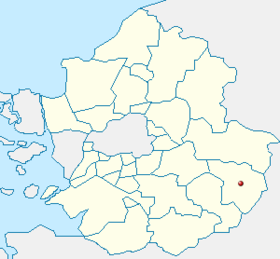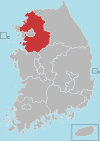Yeoju
Appearance
Yeoju
여주 驪州 | |
|---|---|
| Korean transcription(s) | |
| • Hangul | 여주군 |
| • Hanja | 驪州郡 |
| • Revised Romanization | Yeoju-gun |
| • McCune-Reischauer | Yŏju kun |
 | |
 | |
| Country | |
| Region | Sudogwon |
| Administrative divisions | 1 eup, 9 myeon |
| Area | |
| • Total | 608.64 km2 (235.00 sq mi) |
| Population | |
| • Total | 104,774 |
| • Density | 172.1/km2 (446/sq mi) |
| • Dialect | Seoul |
Yeoju County is a county in Gyeonggi Province, South Korea. Together with the neighboring city of Icheon, it is known as a major center of contemporary South Korean ceramics, and hosts the World Ceramic Exposition every year. Other local products of note include rice, sweet potatoes, and yellow melons. Yeoju is the birthplace of Korea's last queen, Empress Myeongseong.[1]
Yeoju's institution of higher learning includes Yeojoo Institute of Technology. The Jungbu Naeryuk Expressway passes through the county.
Legacy from the past
In the county are located:
- The tomb of the nation's most important king, Sejong the Great. This tomb was moved to Yeoju from Seoul in 1469. [2].
- The temple ruins of Godalsaji (c. 764)
- The Moka Buddhist museum
- The walls of Pasaseong fortress
- Silleuksa, the Korea's lone riverside temple
Symbols
Notes
- ^ Birthplace of Empress Myeongseong. 2004. County of Yeoju Website. 25 October 2006 http://yj21.net/eng/tour/remain_04.asp
- ^ Nilsen, R. (2004). Moon Handbooks South Korea, 3rd eds. Avalon Travel Publishing. pp. 295

